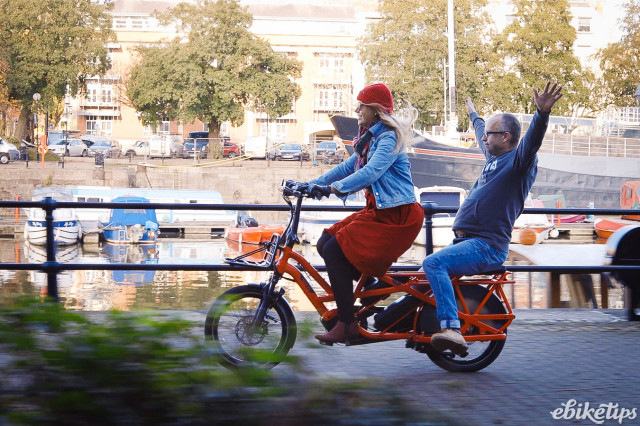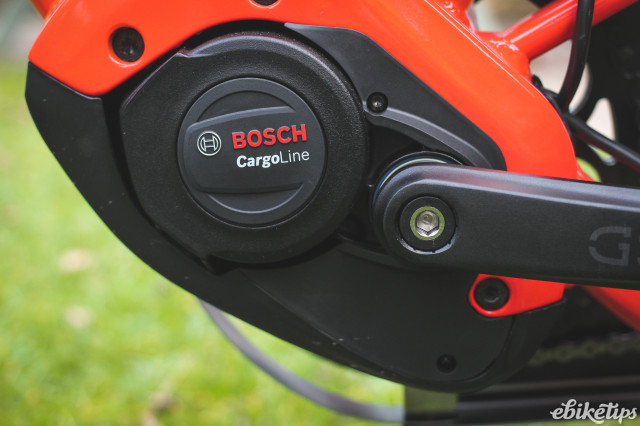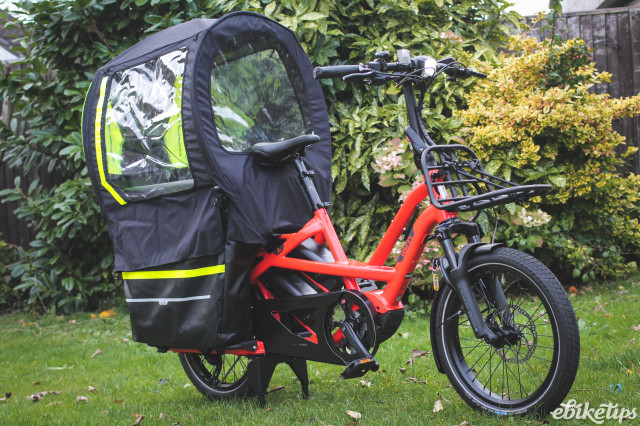Tern GSD S10 2021

Overview
- Updates have improved it
- Incredibly versatile
- High quality
- Limited range on a single battery
- Even more expensive
If you want a versatile, easily-adjustable load carrier and you’ve got the pockets for it, the Tern GSD S10 is as good as they come, carrying people and packages with consummate ease. The updates from the first version have made it a better overall bike, at the expense of, well, some extra expense. This remains, though, the best option for nearly anyone doing normal things on a bike, assuming you can afford it. The other builds are even more expensive than the S10, which starts at £4,499, but for me this is the model to go for.
This is the third GSD we’ve reviewed: we first tried the original GSD S10 back in 2018, followed by the belt-drive S00. In essence the bike is the same: it’s a long-tail cargo bike running on 20” wheels, that can carry passengers or luggage, and it’s easily adjustable for a wide range of rider sizes.
The GSD is built around a low-step alloy frame that’s hugely overbuilt, with the rear rack an integral part of the frame. The new version has been beefed up considerably, with a slightly longer rear cargo area. It's EFBE Tri Test certified and will now handle a combined rider and cargo weight of 200kg (120kg for the rider and 80kg of cargo). As well as that, the new frame has integrated footrails, so you can more easily carry passengers. They’re not especially wide, so if that’s a regular thing you do you’ll probably want to invest in the Sidekick Wide Decks that fit over the top. You’ll want some pads for the rear deck, too. These attach using velcro straps and although they’re perfectly workable they do feel a bit under-designed compared to the rest of the bike, which is the very definition of solid. Everything feels a bit beefier this time around, including the wheels which have been redesigned with extra cooling fins to dissipate braking heat.
The geometry has been tweaked in this new bike. The seatpost is now less upright, which means that the reach of the bike grows more for taller riders who need more seatpost exposed, making it a bit less cramped. As a tall rider myself (1.89m) I did find the change noticeable, and welcome. It was the third most noticeable change on the new bike.
The second most noticeable change is the addition of a suspension fork to the bike. Small wheels and a hugely stiff frame don’t necessarily make for the most comfortable of rides, even with the large-chamber Schwalbe Big Apple/Super Moto X tyres soaking up some of the road chatter. So although I’m not a huge fan of suspension forks on most city bikes - they tend to be badly damped and flexy - it makes sense here. It’s helped by that fact that the small wheels make the fork more compact and less prone to flex than a comparably-priced fork for a standard city wheel. It’s enough suspension to take the edge off poor road surfaces without really being noticeable for the wrong reasons. Tern have added a nurse’s lock as standard to all the GSD models this time around, which makes sense if you’re running errands. It’s a lot of bike to carry off if it’s only locked to itself.
And the most noticeable change is - drum roll - the motor. All three bikes get Bosch’s Cargo Line motor, which is a considerable step up from the Performance Line motor that was previously used on this model. With a maximum assistance of 400% and a maximum torque of 85Nm it’s just the ticket for getting going from the lights with a full complement of kids or shopping on the back. Heading up my benchmark commuting hill (1.5km at an average of 5%, with a 12% section) was never an issue, even with a grown-up on the bench seat. Okay, you need to put a bit of a shift in on the steep stuff with 170kg on the bike, but it’s well within the doable range of effort. If you live somewhere flatter than me, more the better.
There are other changes too. The GSD now comes with a redesigned Atlas Lockstand kickstand, which - the clue is in the name - locks into place and is released using a lever on the handlebars. Because it’s lockable and isn’t relying on the bike’s weight to hold it in place, it can be set a bit higher so it requires less effort to park the bike. If you’re carrying extra-heavy or precious child-shaped loads, there are extenders available to widen the bike’s footprint so it’s even more stable.
This is a heavy bike, and it has a powerful motor. So it’s not a surprise that in the base spec, with a single 400Wh battery, it can drink up all the juice in fairly short order if you’re regularly pointing it at big hills and engaging the higher assistance modes. With two 400Wh batteries on board I found that the range was comparable to a standard Bosch-powered city bike with a single 500Wh battery. Realistically, I think a bike this heavy and powerful should be coming with a minimum of 500Wh on board. I’d love to see the next iteration of this bike use Bosch’s 625Wh Powertube internal unit, at least for the main battery, as that would be enough battery for most use cases short of doing deliveries all day, and you’d only be upgrading to a second battery if you really needed it. The S10 LX version of the GSD gets the 500Wh upgrade as standard, which it needs, and also a suspension seatpost and an upgraded light, which it arguably doesn’t. The lighting system on the GSD is perfectly adequate for anything you're likely to be doing on it, and the rear light has a proper brake light function which works very well.
The Tern GSD is all about versatility, and the range of carrying options has been extended now to cover even more bases. The new bike gets new standard Cargo Hold panniers which are even bigger at 52 litres a side, big enough to swallow a considerable amount of shopping. The panniers are a roll closure, but also fold back in on themselves to form an open-topped soft box you can put bulkier things in. The straps have been redesigned too, with excellent Fidlock magnetic clasps.
If the panniers aren’t enough space there’s a new accessory, the Storm Box, which is a weatherproof enclosure that uses the Clubhouse+ rail accessory as its frame and the Sidekick Wide Decks as its base, and turns the whole of the back of the bike into a single cargo area, extending well above the rack. It’ll swallow 160 litres of cargo, and there’s a tonneau cover to make the load area fully waterproof.
You can also stick your kids in it, in or out of child seats, and if it’s raining there’s a new Storm Shield, a weather-resistant canopy that combines with the Storm Box and other bits mentioned above to create what Tern call the Clubhouse Fort. You can get two primary-age children in it, and transport them to wherever they’re going in the dry, whatever the weather is doing. It’s a really neat bit of modular design and it’s impressively functional, although you’ll be paying for the privilege: the full Clubhouse Fort kit - Clubhouse+ rails, Sidekick Wide Decks, Storm Box and Storm Shield - will add over £700 to the base price of your GSD.
That’s not even all the cargo options. You can have a Shortbed tray atop the rear rack, designed to take a standard 600x400mm euro crate; it can be used in conjunction with the panniers. At the front you can have a smaller Hauler track, or the Transporteur,designed to take the smaller 300x400mm standard crates. Whatever you want to carry, you should be well covered.
However you’ve got it set up, the GSD is an easy bike to live with. Okay, some of the accessories outlined above increase the footprint considerably, and it’s a job getting them on and off. But at its heart the GSD is surprisingly compact. With smaller diameter wheels and a longer frame it’s the same length as a standard city bike, so it’ll fit in the shed the same as anything else. If you’re short on space then it has a couple of extra tricks up its sleeve. The handlebars fold down with a hinge like you’d find on a folding city bike, and the double telescopic seatpost drops all the way into the frame. This lowers and narrows the footprint considerably so it’s viable to store the bike in a hallway. If you don’t even have that much space then the GSD will stand on its end: the rear rack has four feet on the back which allow the bike to be stored vertically. You’ll need a bit of upper body strength to get it upright but it’s surprisingly stable once you have.
Out on the road the GSD is easy to get along with. It’s a pretty mild-mannered bike to ride; there’s no learning curve like you have with a long-john-style cargo bike and the weight distribution, even with a big load on the back, is very good. The small wheels and upright position, coupled with the bike’s overall weight, don’t make for an especially engaging ride but it’s comfortable and easy to pilot. The Bosch motor system is controlled by the basic-but-perfectly-functional Purion display, and the Shimano 10-speed derailleur transmission is functionally flawless. There’s a decent chainguard to stop your trousers getting mucky, too.
The more expensive builds of this bike come with hub gear systems and belt drives, which are lower maintenance and have the benefit of being able to change gear at a standstill which is especially useful when the bike is fully loaded. This derailleur bike is lighter, though, and the drivetrain is more efficient. Derailleurs are a bit more fragile but in this case it could hardly be better protected, and for me it’s all the transmission you need.
Three years down the line the cargo e-bike market isn’t the same place it was when we first laid eyes on the GSD. There are more good cargo bikes to choose from, and a wider range of price points to look at. When it first landed the Tern was miles ahead of the pack, and was rightly our e-bike of the year in 2018. Skip forward to now and the GSD remains, for me, the pick of the bunch: it’s the most practical bike I’ve ever used.
There’s more competition out there though, and although it’s the most versatile bike you can buy there are other bikes to turn the eye if your use case doesn’t require your ride to be quite as one-size-fits-all as this. Bikes like the Benno Boost E, which sacrifices a bit of the load capacity but makes up for it in the fun stakes, are snapping at the GSD’s heels now. The GSD is more expensive than it used to be, and you still need to add accessories to get the most out of it. The base price for the S10 is £4,499; our test bike, with a twin battery setup and various different bits on the back, was well over five grand and getting on for six with the Clubhouse Fort on the back. You’re well into you-could-buy-a-car-for-that territory there. But this is a bike that can replace a car - especially a second car - and like its predecessor it’s easy to recommend. If you have the money, and you want the adaptability, it’s still impossible to beat.
2 comments
I have original S00 version, and I have different views on the bike than this review:
- due to geometry and bike concept, load on front wheel is not sufficient, so it locks during braking too easily (brakes are really great). I have found that out on wet road, crashed, and broken my arm. On no other bike I have ever experienced anything similar, so I do not use bike on wet roads. New frame with slacker seat post only amplifies this.
- what is the maintenance schedule for the fork? This is a utility bike, so suspension service interval is very important.
- How can you fit powertube battery in such small frame? In my use (cargo+kid), one battery is sufficient if you do not use bike on max. assist mode.
- Shimano 10 speed may look ok, but in my experience, due to bike design (small wheels, panniers, frame parts), chain and drivetrain is very difficult to reach for maintenance. Bike demands very strong chain (due to heavy load), so I wonder how long will the cassette last. In my opinion, belt drive should be only option. My version (S00) demands long chain which is not easy to obtain, so I currently run two chains with two quick links. Drivetrain efficiency is not a priority on such heavy bike - I have never ridden it without power.
It is a great utility bike, but with significant drawbacks.
Also consider the Reise and Muller Multi charger Mixte if you are in the market for a lighter, more manageable and fun to ride cargo bike.
For £4k you get 11gears, gen4 bosch cx motor, std 500 battery/625 option and 65kg rear rack.
At 160kg all up rating, it won't (legally) carry a full size adult unless pilot and passenger are both petite but it rides and handles like a normal bike, and at around 27kg and with 26" wheels mine rides surprisingly well off power, allowing me to extend the range on longer rides.
(26" tyres means plenty options too)
Our Mixte frame offers a nice relaxed seating position and is rideable by a range of rider heights.
Highly recommended if you want real cargo bike functionality, but also enjoy riding beyond the city on a range of terrains.












